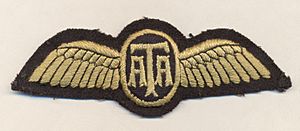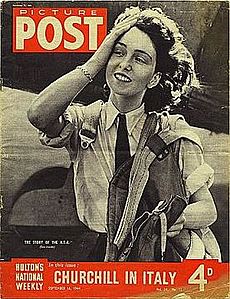Air Transport Auxiliary facts for kids
Quick facts for kids Air Transport Auxiliary |
|
|---|---|

ATA, Air Transport Auxiliary Ferry pilot's badge
|
|
| Active | 15 February 1940–30 November 1945 |
| Country | United Kingdom |
| Size | 16 ferry pools (1944) Air Movement Flight Unit 2 Training Units 1,152 pilots (male) 168 pilots (female) 151 flight engineers 19 radio officers 27 ADCC, ATC, and Sea cadets 2,786 ground staff |
| Command HQ | White Waltham, Maidenhead |
| Nickname(s) | Call sign: Lost Child Ferdinand (overseas) |
| Motto(s) | Latin: Aetheris Avidi "Eager for the Air" Unofficial: Anything To Anywhere |
| Decorations | 2 Commander British Empire (CBE) 13 Officer British Empire (OBE) 36 Member British Empire (MBE) 6 British Empire Medal (BEM) 1 George Medal 6 Commendations 5 Commended for Gallantry 18 King's Commendation for Valuable Service in the Air |
The Air Transport Auxiliary (ATA) was a special British group of civilian pilots. It was formed at the start of World War II in 1940. Their main job was to move military aircraft around the country.
They flew new planes from factories to airfields. They also moved damaged planes for repair. This helped the Royal Air Force (RAF) a lot. RAF combat pilots could then focus on fighting. A cool fact is that some ATA pilots were women. From 1943, they even earned the same pay as men. This was a first for the British government!
Contents
What Did the ATA Do?
The ATA's first idea was to carry people, mail, and medical supplies. But soon, their pilots were needed for a bigger job. They started transporting aircraft for the Royal Air Force (RAF).
By May 1940, the ATA was moving all military aircraft. This included planes from factories to special units. These units would then add guns and other gear. By August 1941, the ATA handled all aircraft ferrying jobs. This was super important. It meant that RAF combat pilots could stay focused on fighting. They didn't have to spend time moving planes.
The ATA had many bases, called "ferry pools." These were spread across the UK. They stretched from Hamble in the south to Lossiemouth in Scotland.
After the war ended, the ATA was closed down. This happened on November 30, 1945. Lord Beaverbrook, a wartime minister, praised their work. He said the ATA helped the RAF greatly during the Battle of Britain. They delivered planes, freeing up RAF pilots for battle.
How Much Did the ATA Achieve?
During World War II, the ATA flew for a huge amount of time. They spent 415,000 hours in the air. They delivered over 309,000 aircraft. These planes were of 147 different types. Some famous planes they moved included Spitfires and Hurricanes. They also flew large bombers like Lancasters and Halifaxes.
The ATA also transported freight and passengers. They moved about 883 tons of cargo. They carried 3,430 passengers safely. Sadly, 174 ATA pilots died during the war. Both men and women pilots lost their lives.
Because these were delivery flights, the aircraft guns were not loaded. This was because ATA staff were civilians. They were not military soldiers. So, they couldn't legally fly armed planes.
How Was the ATA Managed?
Gerard d'Erlanger was in charge of the ATA's management. He was a director at British Airways Ltd. He first suggested the idea for the ATA in 1938. At first, the Air Ministry wasn't very keen. But as war became likely, they agreed to his plan. The ATA officially started in 1939.
The ATA's main control center was at RAF Andover. This is where they decided which flights each ferry pool would handle. The ATA's main base was at White Waltham. This was near Maidenhead in Berkshire.
The ATA was managed by different groups over time. But Gerard d’Erlanger always led the staff. He made sure everything ran smoothly.
Who Were the ATA Pilots?
The ATA hired pilots who couldn't join the RAF. This was often due to their age, health, or gender. A unique thing about the ATA was that they looked past physical disabilities. If a pilot could do the job, they were hired. This meant there were pilots with one arm or one eye. People sometimes joked they were "Ancient and Tattered Airmen."
Pilots came from many different countries. People from 28 nations flew with the ATA. This included both neutral and fighting countries.
Women Pilots: The Attagirls
One of the most famous things about the ATA was its women pilots. They were often called "Attagirls" in the news. On November 14, 1939, Pauline Gower was asked to organize the women's section.
The first eight women pilots joined on January 1, 1940. They started by flying smaller planes. Soon, they were allowed to fly many types of aircraft. This included trainers and transport planes. Eventually, women pilots flew almost every type of plane. They even flew large four-engined bombers. They started flying Hurricanes in July 1941. Spitfires followed in August 1941.
Overall, 166 women pilots served in the ATA during the war. This was one out of every eight ATA pilots. They came from Britain, Canada, Australia, and the United States. Some famous women pilots included Amy Johnson and Maureen Dunlop. Sadly, 15 of these brave women died while flying.
A very important change happened in 1943. Women pilots in the ATA started receiving the same pay as men. This was a huge step forward! It was the first time the British government agreed to equal pay for equal work.
How Did ATA Pilots Train?
The ATA quickly created its own training program. Pilots learned to fly different types of aircraft in stages. They started with light, single-engined planes. Then they moved on to more powerful and complex ones.
Pilots first qualified on "Class 1" aircraft. These were planes like the Tiger Moth. After gaining experience, they moved to "Class 2" advanced single-engined planes. This process continued for twin-engined planes (Class 3 and 4).
Once a pilot was cleared for a class, they could fly any plane in it. Even if they hadn't seen that specific plane before! They used special "ATA Pilots Notes." These were small cards with important details for each aircraft.
For the largest four-engined planes (Class 5), pilots trained on the Halifax bomber. Then they could fly other similar types. When flying these big planes, a flight engineer always joined the pilot.
The ATA only trained pilots to deliver planes safely. They didn't teach fancy flying moves like aerobatics. In fact, pilots were told not to do them. This was to avoid unnecessary risks. The goal was always to deliver the aircraft safely.
ATA Ranks
| ATA rank | Commodore | Senior Commander | Commander | Captain and Flight Captain |
First Officer | Second Officer | Third Officer | Cadet |
|---|---|---|---|---|---|---|---|---|
| Rank insignia |  |
 |
 |
 |
 |
 |
 |
ATA rank badges were worn on the shoulder straps of their uniforms.
See Also
Images for kids






